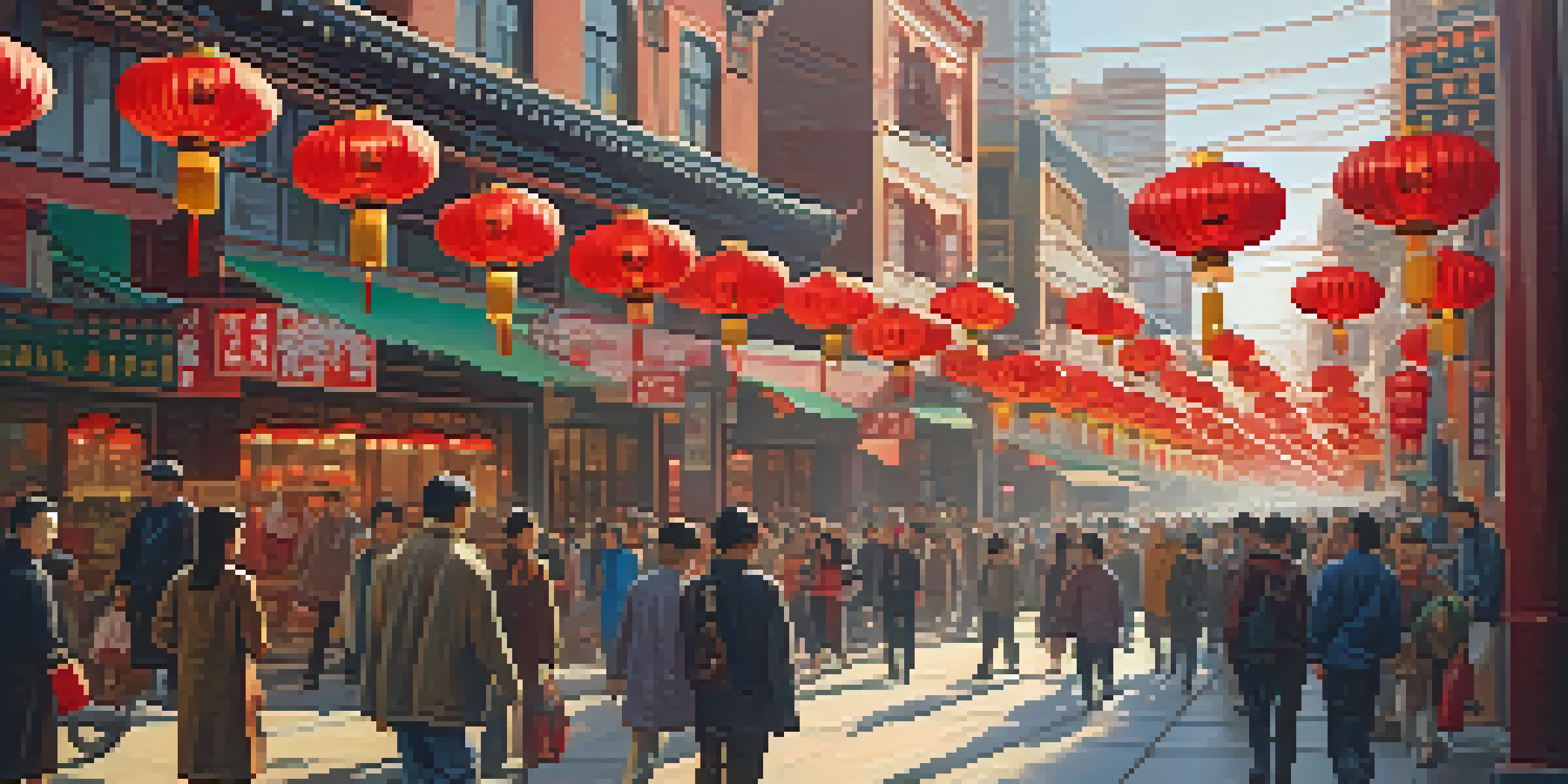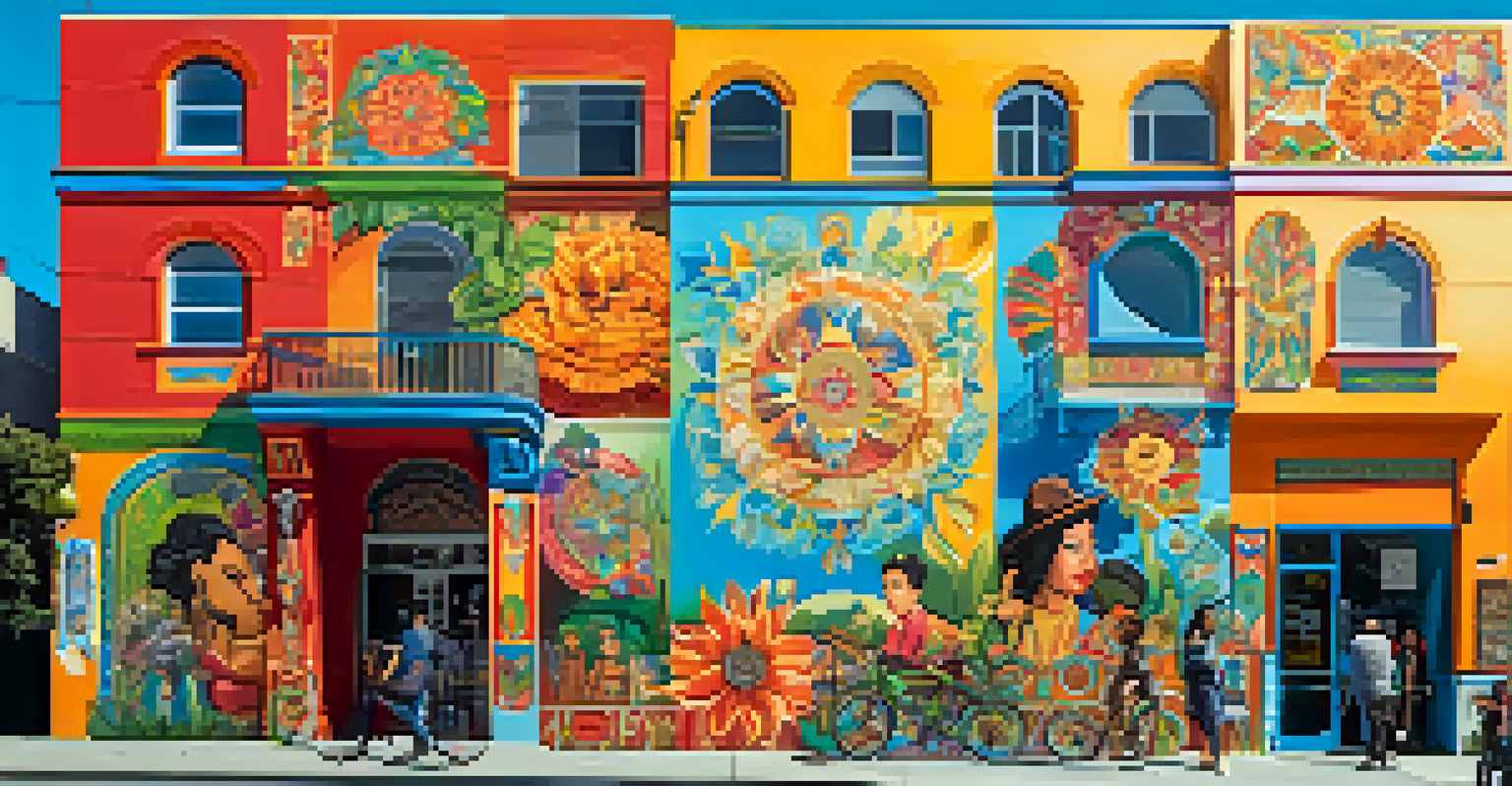The Impact of Immigration on San Francisco's Languages

The Linguistic Melting Pot of San Francisco
San Francisco is a vibrant tapestry of languages, reflecting its rich history of immigration. Over the years, waves of immigrants have brought their languages, cultures, and traditions, creating a unique linguistic environment. From Chinese and Spanish to Tagalog and Russian, the city's streets echo with a multitude of voices, each telling its own story.
A different language is a different vision of life.
This diversity is not just a backdrop but a fundamental aspect of the city's identity. It's common to hear conversations in several languages while walking through neighborhoods like Chinatown or the Mission District. These areas are living examples of how immigration has shaped the local culture and community.
Moreover, this linguistic variety enriches the social fabric of San Francisco, fostering connections among different cultural groups. It encourages residents to learn new languages, promoting inclusivity and understanding in an increasingly globalized world.
Influence of Chinese Immigration on Local Dialects
Chinese immigrants have significantly influenced the linguistic landscape of San Francisco, contributing not only the Chinese language but also various dialects. Cantonese, in particular, has become a staple in the city's Chinatown, where signs, shops, and services cater primarily to Cantonese speakers. This prevalence highlights how immigration can lead to a linguistic stronghold in specific neighborhoods.

The introduction of Chinese culture and language has also prompted a ripple effect, encouraging non-Chinese residents to learn about Chinese traditions and language. This curiosity fosters a mutual appreciation and respect among cultures, enhancing community ties.
Diverse Languages Shape Identity
San Francisco's rich linguistic tapestry, influenced by various immigrant communities, is a fundamental aspect of the city's cultural identity.
As a result, the influence of Chinese immigration extends beyond mere language; it has shaped cultural events, culinary offerings, and even local politics, making it an integral part of San Francisco's identity.
The Role of Spanish in San Francisco's Communities
Spanish, owing to the historical presence of Latino communities, is another prominent language in San Francisco. The Mission District, known for its vibrant murals and rich cultural heritage, serves as a hub for Spanish speakers. Street signs, community events, and local businesses often reflect this linguistic landscape, highlighting the importance of Spanish in daily life.
Language is the roadmap of a culture. It tells you where its people come from and where they are going.
The bilingual nature of the city allows for a unique blend of cultures, as Spanish speakers and English speakers interact in various settings. This cultural exchange fosters an environment where both languages thrive, enriching the overall community experience.
Moreover, the visibility of Spanish has encouraged initiatives aimed at promoting bilingual education. Schools and community programs often emphasize the importance of language learning, ensuring that future generations appreciate this cultural legacy.
Emerging Languages from Recent Immigrant Communities
In recent years, San Francisco has seen an influx of immigrants from various countries, introducing new languages to the city. Languages such as Tagalog, Vietnamese, and Russian are becoming increasingly visible, especially in neighborhoods with high concentrations of these communities. This linguistic evolution reflects the dynamic nature of immigration and its impact on the local culture.
With the arrival of these new communities, local businesses, schools, and public services are adapting to meet the needs of diverse populations. Bilingual signage and language classes are becoming more common, highlighting the city's commitment to inclusivity.
Challenges in Language Preservation
Urbanization and gentrification pose significant challenges to preserving lesser-spoken languages among younger generations in San Francisco.
As these languages gain prominence, they contribute to the overall diversity of San Francisco, enriching the cultural dialogue and offering residents a chance to engage with different perspectives and traditions.
The Impact of Technology on Language Use
Technology plays a crucial role in shaping how languages are used and learned in San Francisco. With the rise of social media, messaging apps, and online learning platforms, residents can easily connect and communicate in various languages. This accessibility has led to an increase in language exchange opportunities, where individuals can practice and learn from each other.
Moreover, tech companies in San Francisco often prioritize multilingual support in their products, reflecting the city's diverse population. This focus not only accommodates non-English speakers but also fosters a sense of belonging in a fast-paced digital world.
As a result, technology is not just a tool for communication; it actively contributes to the preservation and evolution of languages, ensuring that they remain relevant in contemporary society.
Challenges of Language Preservation in Urban Areas
Despite the rich linguistic diversity, there are challenges to preserving these languages in urban environments like San Francisco. The fast-paced nature of city life can lead to language erosion, especially among younger generations who may prioritize English for social and professional opportunities. This shift poses a risk to the survival of less widely spoken languages.
Additionally, gentrification can displace established communities, further threatening the use of their native languages. As neighborhoods change, the cultural significance of these languages may diminish, leading to a loss of heritage and identity.
Celebration of Multicultural Events
Festivals and cultural events in San Francisco highlight and celebrate the city's linguistic diversity, fostering community engagement and appreciation.
Addressing these challenges requires concerted efforts from community organizations, schools, and local governments to promote language learning and support cultural initiatives. By valuing linguistic diversity, we can help ensure that the rich tapestry of San Francisco's languages continues to thrive.
Celebrating Linguistic Diversity through Festivals and Events
San Francisco hosts numerous festivals and events that celebrate its linguistic diversity, showcasing the city's multicultural heritage. Events like the Chinese New Year Parade and the Día de los Muertos celebration in the Mission District highlight the importance of language and culture in community gatherings. These festivities create opportunities for residents to engage with and appreciate different languages.
Through music, dance, and art, these events foster a sense of unity among diverse groups, emphasizing the beauty of linguistic differences. They also serve as educational platforms, encouraging attendees to learn about the languages and cultures represented.

By celebrating linguistic diversity, San Francisco reinforces its commitment to inclusivity and multiculturalism, reminding residents of the rich narratives that each language carries within the community.
The Future of Languages in San Francisco's Immigrant Communities
Looking ahead, the future of languages in San Francisco's immigrant communities is both promising and complex. As new generations grow up in a bilingual environment, they have the potential to carry forward their heritage languages while also mastering English. This bilingualism can enhance cognitive skills and broaden cultural perspectives, creating a more interconnected community.
However, it will be crucial for families and community leaders to advocate for language preservation through education and cultural initiatives. By supporting bilingual education and language programs, they can help ensure that younger generations remain connected to their roots.
Ultimately, the linguistic landscape of San Francisco will continue to evolve, reflecting the city's dynamic history and the ongoing influence of immigration. Embracing this change will help foster a vibrant and inclusive community for years to come.